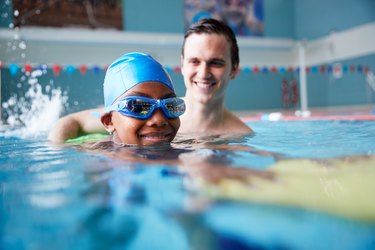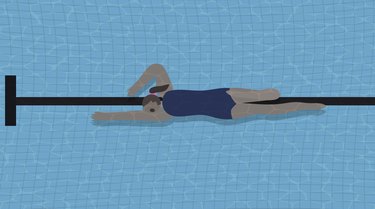
Teaching someone to swim is incredibly rewarding — you're providing a skill that could save a life. According to 2019 Gallup poll across 142 countries, nearly 55 percent of those 15 and older can't swim unassisted. How to teach someone to swim depends on their age and comfort level in the water.
Teaching someone how to swim requires patience, creativity and an understanding of swim safety and technique. Look into getting certified through an organization like the American Red Cross or SwimAmerica if you want to teach lessons on a regular basis.
Video of the Day
Video of the Day
Colorado-based triathlon and swim coach Alison Freeman is well-versed in how to teach someone how to swim — she has taught more than 75 "adult-onset" swimmers how to swim over the past eight years.
Freeman shares her tips below for teaching a beginner how to swim safely and with good swim technique.
Warning
Teaching beginners to swim can be dangerous. Never to leave anyone alone unsupervised, and if you're teaching a group, make sure that another adult or lifeguard is watching the group while you aren't working with them.
Many children and adults develop lifelong fear of water because some well-meaning person dunked them or pushed them in water unexpectedly. Never use scare tactics while teaching swimming.
How to Teach Swim Lessons
Be Prepared
First, create swimming lesson plans for beginners. If you don't know what you want to cover in a day, you won't efficiently teach the class. Make sure you consciously break down the skills of swimming into smaller, digestible pieces. The Red Cross's swim lesson plans can help guide you.
When considering lesson plans for how to teach someone how to swim, Freeman offers three basic skills to include in each session:
- Body position: Whether the swimmer is just starting to learn how to float or can already swim basic freestyle, teaching them to hold a neutral/flat body position in the water is a key component of good swim form.
- Breathing: Specifically, breathing out under water. New swimmers tend to hold their breath while swimming, so teaching them to slowly breathe out while their face is in the water both keeps their heart rate down and means they only need to breathe in when they turn their head above water.
- Stroke-based forward propulsion: New swimmers gravitate toward creating propulsion through their kick. Instilling the concept that swimming involves creating propulsion through the pull-phase of the swim stroke, as the arm moves underwater (moving water with their arms, versus moving their arms through the water), helps translate that concept to swim technique.
Incorporating drills and intentional exercises to teach new swimmers how to become comfortable with these abilities in the water will make for a well-structured swim lesson.
Be sure to set up your equipment before class. Gather your supplies — kickboards, pool noodles, buoys, goggles, etc. — and have them waiting where you'll hold the class.
Start Slowly
In your very first session, introduce swimmers to the water. Freeman suggests that when teaching someone how to swim, encouraging the swimmer to get comfortable putting their face in the water as well as floating on both the stomach and back are great things to work on initially.
"Start where the athlete is," Freeman says. "Some beginner swimmers need to start by learning to float and some will dive in and attempt freestyle right away."
As they become more comfortable putting their face in the water, have the swimmer blow bubbles with their face submerged, then turn their head to the side. This introduces rudimentary rotary breathing, a necessary skill for breathing while swimming.
In time, an athlete can also begin to use a kickboard to incorporate a kicking motion into their swim stroke. A kickboard can also be a useful tool in understanding how to float when the beginner swimmer is learning how to stay afloat on both their stomach and back.
One Thing at a Time
Freeman knows it can be tempting as a coach to give lots of instruction when teaching someone to swim But in her own learning of how to teach someone how to swim, she knows this can backfire.
"Only ask the swimmer to work on one thing at a time," Freeman says. "The athlete may have multiple important corrections to improve their swim stroke, but they can only focus on one thing at a time while swimming — and only a handful of corrections during a single swim lesson."
The skill of how to teach someone how to swim means always building to the final goal of proper swim technique (and not teaching bad habits), Freeman says. For example, if a swimmer is practicing kicking with a kickboard, they should have their face in the water to practice exhaling into the water and turning their head to the side to breathe.
Combine Skills and Celebrate
Once the beginner swimmer has a handle on basic skills, it is time to start putting them all together. Instruct them to hold the kickboard while kicking and doing rotary breathing. Then, teach submersion and breath holding by asking the students to retrieve objects from the bottom of the shallow end. Eventually, students can build on these skills to become confident freestyle swimmers.
Freeman suggests incorporating swim fins and a swim snorkel when the beginner swimmer is first endeavoring to combine their newfound skills.
According to Freeman, swim fins can prevent a swimmer's legs from sinking and teach the swimmer to use the power of their kick for forward propulsion. A swim snorkel can take the stress of mastering rotary breathing away temporarily and help the swimmer to focus on their body position instead.
It is key to remember that the process of learning how to teach someone to swim can take many months — even a year or more. During this time, Freeman reminds instructors to celebrate the small wins.
"Reinforce what the athlete is doing well each swim session," Freeman says. "There will be a seemingly endless list of corrections the swimmer could make, and it's important to balance the swim technique fixes with positive reinforcement."
Tip
Expect teaching swimming to take awhile. Have fun and be patient.
Think creatively when coming up with games and ways to teach the skills. Every individual learns differently, so you may need to switch things up occasionally.
5 Swimming Drills for Beginners
The skills required for swimming are acquired gradually and people learn these skills at different speeds. Swimming drills for all swimmers can help them learn how to swim efficiently and confidently. Keep in mind that teaching someone how to swim may involve modifying these drills to suit the swimmer's needs.
As new swimmers practice these pool drills, they'll become more competent and will begin to perform it automatically, leading to successful swimming of various strokes.
1. Push and Glide
After someone has gained some initial water confidence, you can teach them the essential skill of pushing and gliding. This swimming drill introduces the skill that forms the basis of swimming starts and turns.
Initially, you can teach them to start from standing and push off the pool floor with their feet and reach for the poolside. You can then teach them to push away from the side and glide to a partner who can catch them. As confidence improves, learners can progress to pushing, gliding and standing up on their own.
Teach people to do this drill with their arms outstretched and face in the water with the toes pointed. This introduces the streamlined body shape that forms the basis of swimming starts and turns and the correct body position for swimming front crawl.
2. Kicking and Breathing Drill
This drill is excellent for teaching beginners how to swim, according to Freeman.
Have the swimmer kick while holding a kickboard with straight, outstretched arms and with their face in the water. Then, encourage the swimmer to kick with a slight bend at the knees and with their heels at the water's surface to promote a neutral body position.
The swimmer should exhale under water and turn their head to the side to breathe, as this reinforces good breathing technique. The swimmer should practice this drill for at least a couple lengths of the pool until they feel confident in their ability to maintain a neutral body position while turning to breathe.
This drill can progress into the swimmer holding the kickboard with one arm and doing a stroke with the other, until that arm catches up to the other arm at the kickboard, and then the second arm does a stroke, continuing for a whole lap.
3. Black Line Drill

Most pools have a black line (it may be a different color) at the bottom of each pool lane. These lines help swimmers know that they are swimming straight and when they are about to reach the pool wall. In this drill, swimmers will use the black line to work on their hand entry into the water.
The swimmer should aim to swim in the center of the lane and keep their arms just outside the black line, especially as their hand enters the water. This is harder than it sounds in most cases, but helps the beginner swimmer learn to keep their hand entry directly in line with their shoulder and to maintain a straight trajectory of their arm from entry to stroke exit.
4. Glove Drill

The glove drill also teaches proper hand entry into the water and builds upon the black line and kicking and breathing drills. Correct hand entry into the water can prevent a host of shoulder and back issues later on and is a critical skill for a beginner swimmer to learn.
In this drill, Freeman instructs the swimmer to envision their hand entry into the water as if their hand is sliding into a glove that is "a few inches under the water, pointed slightly downward, and at the end of the swimmer's reach."
This visualization promotes proper hand entry as well as shoulder rotation upon the hand submerging into the water.
5. The Spork Drill

It is common for beginner swimmers to either hold their fingers and hands together too tightly, or conversely, not put enough tension into their fingers and wrists to effectively pull themselves through the water.
The spork drill asks swimmers to pretend their hands are sporks, the utensil that has a curved "palm" and pointy "fingers" and may be used in camping gear or to eat dishes that involve both broth and noodles.
In the spork drill, the swimmer should position their fingers as if their hands are sporks, with their palms neutral or slightly curved, and about a quarter-inch separation between their fingers. This hand position is optimal for pulling the swimmer through the water with each stroke without cramping their hand or losing water between their fingers.
Related Reading
How to Become a Swim Instructor
To understand how to teach someone how to swim, it is critical to invest in training and certification. Teaching a child or adult how to swim provides a low-impact aerobic activity that lasts a lifetime. Swim lessons are offered at many pools and YMCA facilities.
Swim Lesson Certification
Many organizations help people acquire swim lesson certification. The American Red Cross is one of the main organizations offering a swimming instructor course and testing. A swimming pretest is given to all applicants followed by training courses and a final written test.
Certification level depends on the individual's ability to successfully pass all courses as well as the duration of level 1 instruction. The American Red Cross also provides CPR classes to all instructor trainees.
Aquatic Teaching Foundation Unit
The Aquatic Teaching Foundation Unit (ATFU) is the core of swimming instructor training and covers the basics of swimming safety. Further certification training courses are designed around your level of education and dedication.
For example, certification to teach beginners requires that candidates be at least 16 years old, acquire the Safeguarding and Promoting the Welfare of Children certification, CPR certification and a 20-hour training course in beginner swim technique.
Advanced Instruction
Applicants who are at least 18 and have certain qualifications such as teaching degrees in primary education are eligible for swimming certifications through distance learning, such as U.S. Masters Swimming or USA Swimming.
These specialized certifications require the same training as beginner instructors as well as extended hours to earn a higher certification such as aquatics and intermediate. Requiring between 16 and 36 hours of instruction time, these certifications allow swim instructors to teach people of all ages without supervision from a senior instructor.
Working as a Swimming Instructor
Once you have completed your qualification courses and received your certifications, employment is the next step. Becoming associated with a well-known swimming organization such as the YMCA or U.S. Masters Swimming will help you gain experience and progress toward independent swim instruction.
When providing private swim instruction, you need insurance to cover yourself and your students in case an accident occurs. This type of insurance is called general liability insurance and should not be forgotten in your checklist to becoming a private swim instructor. Some employers will handle this insurance for you if you're an employee teaching at their facility.
Always make your credentials available to students and parents (if teaching minors) and submit all paperwork in a timely manner when partnering with other organizations.
Related Reading
- American Red Cross: "Swim Instructor Certification"
- SwimAmerica: "SwimAmerica Licensing"
- American Red Cross: "Swim Classes"
- USA Swimming: "Learn to Swim"
- YMCA: "Water Safety and Swim Lessons"
- Red Cross: "Swimming Lessons for Kids"
- Majority Worldwide Cannot Swim; Most of Them Are Women
- What Does Commercial General Liability (CGL) Insurance Cover?